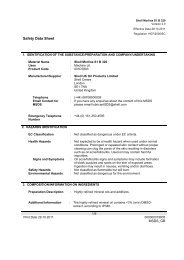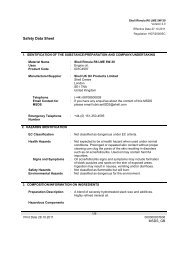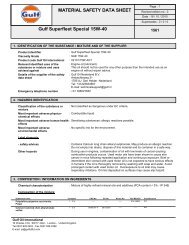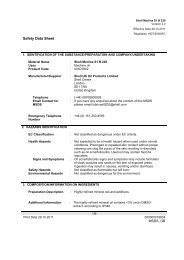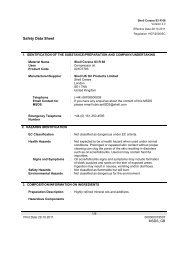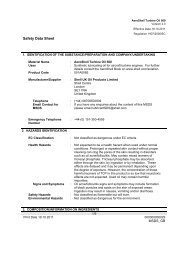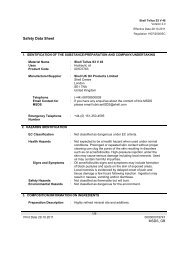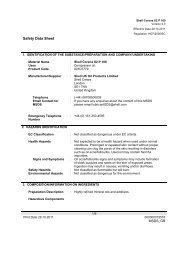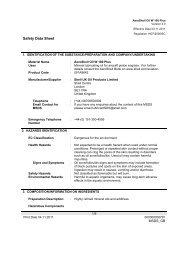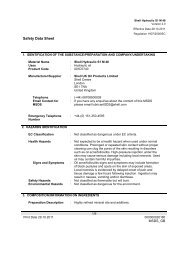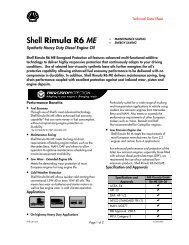Gadus S3 V220C 2.pdf - OilsandStuff
Gadus S3 V220C 2.pdf - OilsandStuff
Gadus S3 V220C 2.pdf - OilsandStuff
You also want an ePaper? Increase the reach of your titles
YUMPU automatically turns print PDFs into web optimized ePapers that Google loves.
Material Safety Data Sheet<br />
Shell <strong>Gadus</strong> <strong>S3</strong> <strong>V220C</strong> 2<br />
Version 1.0<br />
Effective Date 02.12.2010<br />
Regulation 1907/2006/EC<br />
EC R-phrases.<br />
4. FIRST AID MEASURES<br />
General Information : Not expected to be a health hazard when used under normal<br />
conditions.<br />
Inhalation : No treatment necessary under normal conditions of use. If<br />
symptoms persist, obtain medical advice.<br />
Skin Contact : Remove contaminated clothing. Flush exposed area with water<br />
and follow by washing with soap if available. If persistent<br />
irritation occurs, obtain medical attention. When using high<br />
pressure equipment, injection of product under the skin can<br />
occur. If high pressure injuries occur, the casualty should be<br />
sent immediately to a hospital. Do not wait for symptoms to<br />
develop. Obtain medical attention even in the absence of<br />
apparent wounds.<br />
Eye Contact : Flush eye with copious quantities of water. If persistent<br />
irritation occurs, obtain medical attention.<br />
Ingestion : In general no treatment is necessary unless large quantities<br />
are swallowed, however, get medical advice.<br />
Advice to Physician : Treat symptomatically. High pressure injection injuries require<br />
prompt surgical intervention and possibly steroid therapy, to<br />
minimise tissue damage and loss of function. Because entry<br />
wounds are small and do not reflect the seriousness of the<br />
underlying damage, surgical exploration to determine the<br />
extent of involvement may be necessary. Local anaesthetics or<br />
hot soaks should be avoided because they can contribute to<br />
swelling, vasospasm and ischaemia. Prompt surgical<br />
decompression, debridement and evacuation of foreign<br />
material should be performed under general anaesthetics, and<br />
wide exploration is essential.<br />
5. FIRE FIGHTING MEASURES<br />
Clear fire area of all non-emergency personnel.<br />
Specific Hazards : Hazardous combustion products may include: A complex<br />
mixture of airborne solid and liquid particulates and gases<br />
(smoke). Carbon monoxide. Unidentified organic and inorganic<br />
compounds.<br />
Suitable Extinguishing<br />
Media<br />
: Foam, water spray or fog. Dry chemical powder, carbon<br />
dioxide, sand or earth may be used for small fires only.<br />
Unsuitable Extinguishing : Do not use water in a jet.<br />
Media<br />
Protective Equipment for<br />
Firefighters<br />
6. ACCIDENTAL RELEASE MEASURES<br />
: Proper protective equipment including breathing apparatus<br />
must be worn when approaching a fire in a confined space.<br />
Avoid contact with spilled or released material. For guidance on selection of personal protective<br />
equipment see Chapter 8 of this Material Safety Data Sheet. See Chapter 13 for information on<br />
disposal. Observe the relevant local and international regulations.<br />
Print Date 03.12.2010<br />
2/8<br />
MSDS_GB



